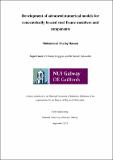| dc.contributor.advisor | Goggins, Jamie | |
| dc.contributor.advisor | Suhaib, Salawdeh | |
| dc.contributor.author | Hassan, Muhammad Shariq | |
| dc.date.accessioned | 2019-02-19T09:19:32Z | |
| dc.date.available | 2019-02-19T09:19:32Z | |
| dc.date.issued | 2018-09-18 | |
| dc.identifier.uri | http://hdl.handle.net/10379/14972 | |
| dc.description.abstract | The behaviours of braced steel frame members and components are investigated in this project using finite element models that were developed to address the multi-scale mechanics of braced steel frame structures. The multi-scale mechanics are based on three assessment scale levels; that is, material (coupons), elemental (bracing steel structural members) and component (brace gusset-plate structural members) levels. Each finite element model was validated with data from physical laboratory tests. The models were then used to assess the current European code of practice in the seismic design of braced steel frames, as well as existing empirical models and numerical models, and to derive new relationships for a number of design parameters.
The framework developed for finite element modelling of steel concentrically braced frame structures followed conventional guidelines for 3D non-linear modelling but included novel advanced modelling techniques such as the extended finite element method-based crack growth model development, automated generation of initial imperfections in the brace member and an innovative material modelling methodology application. Importantly, realistic detailing for gusset plates and brace members were employed in the study. The framework of modelling was developed in the commercial finite element package ABAQUS v.6.13.
The performance of finite element models was assessed against various measured parameters obtained from physical laboratory tests, such as buckling compressive loads, initial yield load, tensile load, ductility capacity, energy dissipative capacity, cycles to initiation of global and local buckling, fatigue-life capacity and failure modes. It was found that the finite element models predicted these response features within engineering accuracy, for multi-scale mechanical behaviour of braced steel frame members and components, when subjected to both static monotonic and cyclic ultra-low cycle fatigue loading regimes. Thus, the finite element models proposed in this study can be used with confidence both in academic studies and by engineering professionals for analyse and design of safer and robust structures, as they were calibrated and validated using physical test data. | en_IE |
| dc.publisher | NUI Galway | |
| dc.rights | Attribution-NonCommercial-NoDerivs 3.0 Ireland | |
| dc.rights.uri | https://creativecommons.org/licenses/by-nc-nd/3.0/ie/ | |
| dc.subject | Concentrically braced frames | en_IE |
| dc.subject | Finite element modelling | en_IE |
| dc.subject | Steel | en_IE |
| dc.subject | Structural engineering | en_IE |
| dc.subject | Extended finite element method | en_IE |
| dc.subject | Fatigue | en_IE |
| dc.subject | Gusset plate | en_IE |
| dc.subject | Steel brace | en_IE |
| dc.subject | Imperfection | en_IE |
| dc.subject | Static | en_IE |
| dc.subject | Quasi static cyclic | en_IE |
| dc.subject | Engineering and Informatics | en_IE |
| dc.subject | Civil Engineering | en_IE |
| dc.title | Development of advanced numerical models for concentrically braced steel frame members and components | en_IE |
| dc.type | Thesis | en |
| dc.contributor.funder | College of Engineering and Informatics, National University of Ireland, Galway | en_IE |
| dc.contributor.funder | Centre for Marine and Renewable Energy (MaREI) | en_IE |
| dc.contributor.funder | Civil Engineering Research Association of Ireland (CERAI) | en_IE |
| dc.local.note | An advanced finite element framework for computational design and analysis methodology of both steel brace and brace gusset-plate component was developed incorporating material modeling, optimum element and mesh sizes, static and fatigue damage analysis, imperfection models and numerical analysis methods. | en_IE |
| dc.local.final | Yes | en_IE |
| nui.item.downloads | 948 | |


